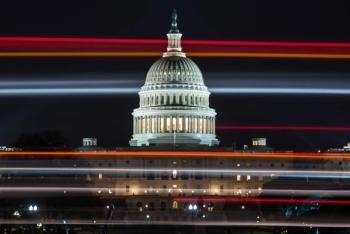
Why hospitals are likely to see IV fluid shortage for some time
Health systems nationwide are working to conserve supplies after disruptions from Hurricane Helene. Tom Cotter of Healthcare Ready explains why there’s no quick fix.
Many hospitals are making plans to deal with the shortage of sterile intravenous fluids, and officials say conservation strategies are going to be needed for the near future.
Federal officials are working to help obtain more IV fluids, but Cotter tells Chief Healthcare Executive® that it’s going to take a while before health systems see some relief. Even if more supplies come from abroad, they won’t arrive overnight.
“It's a liquid and it's heavy, so it's really difficult to fly significant and substantial quantities to ease a national shortage of IV solutions,” Cotter says. “So it's all going to be floated by boat, which can take some time.”
Last week, Xavier Becerra, the U.S. secretary of health and human services, told healthcare leaders that
Federal officials are working to find suppliers who can produce more IV fluids, Becerra said in a
Paul W. Abramowitz, CEO of the American Society of Health-System Pharmacists (ASHP), wrote in a
Given the need to ship more supplies from overseas, Cotter says there isn’t a quick fix to the problem.
The Baxter plant produces 60% of the IV fluids used nationwide, or about 1.5 million bags per day, according to the American Hospital Association. And the plant has been offline for more than two weeks.
“There is no silver bullet for this,” Cotter says. “This is going to take multiple strategies to mitigate the impacts of this, whether the plant comes online tomorrow or it comes online in December. There needs to be a multi-pronged approach to ensure that this doesn't significantly impact patients.”
It’s also not easy to find other suppliers capable of producing IV fluids, and it can’t be done at the flip of a switch.
“Something as specialized as sterile, fluid IV solution, there's a massive barrier to entry there,” Cotter says. “It's not like any company can just start up this. This is a really specialized manufacturing process that requires a lot of robots and upfront investment that most companies cannot do.”
“It's difficult because of the sterility,” he explains. “A company that produces it has to 100% guarantee sterility of the product inside the bag, and that is insanely difficult to do.”
Baxter has said the company hopes to approach full production levels at the North Carolina plant by the end of the year.
Cotter says the healthcare industry avoided a more damaging blow to IV supplies when another key plant in Florida avoided major damage from Hurricane Milton, which hit the state last week. B. Braun Medical, which owns the plant in Daytona Beach, said the facility didn’t suffer any serious problems, as the
The disruption tied to the Baxter plant going offline offers yet more evidence that the healthcare supply chain needs substantial improvement, Cotter says.
While Cotter says it’s not ideal for the bulk of key medical supplies to come from any one plant, he also says he understands the business realities that prevent companies from opening a dozen separate plants to produce their materials. During the COVID-19 pandemic,
“I think there's a lot of conversation that needs to be had around how best to create more resiliency among up and down our supply chain,” Cotter says, adding, “There has to be an intervention somewhere to increase the investments into hardening and building resiliency.”
Over the past year, hospitals and health systems have encountered shortages of
The association has asked the White House to invoke the Defense Production Act to spur manufacturers to produce more IV solutions and containers.
The Food and Drug Administration last week issued

















































